SEL Facilitator's Guide
View, Download, Print pdf. version of the SEL Facilitator's Guide
Social Emotional Learning (SEL) and You!
A Facilitator's Guide
Overview
This module is intended to initiate conversations about substance use among teenagers in rural settings by utilizing the Social Emotional Learning (SEL) framework and activities. To achieve this, the module is designed to be very interactive. The goal is to normalize having discussions about drug and alcohol use with a supportive, safe, non-judgmental adult, to allow misconceptions about peer drug and alcohol use to be debunked, and to do all of this while learning important SEL skills. The instructor who leads the process will act as a facilitator, encouraging interaction.
The facilitator will go through the PowerPoint (PPT) presentation with the students, welcoming and inviting interaction at all times. Following the PPT review, the class should be broken into five small groups to do the activity worksheets. To keep the students engaged, it is suggested to have five stations with a white board/large piece of paper/chalkboard, where the students can write answers they come up with for each activity. The groups should be given time at each station to write on their worksheets and share answers with each other by writing them on that station’s board. They will then rotate until they have been to all five stations. Utilizing stations with large writing areas will serve two purposes: 1. Keep a record of each group’s answers to enable a discussion with the entire class after all groups have gone to each station, and 2. To allow the students to see how many different possible ways there are to approach the same activity.
The following pages share how to introduce the course and how to guide students through the PPT slides by providing talking and discussion points to successfully facilitate the curriculum.
Hello!
First take a moment to introduce yourself (if you are not already familiar with each other).
Provide the following brief definition of Social Emotional Learning (SEL):
SEL works to provide you with a way to help you understand yourself, the people around you and the world you live in better.
How?
SEL’s tools support people in developing healthy identities (sense of self), understanding and managing personal emotions, building and showing empathy (compassion and the ability to put yourself in someone else’s shoes) for others, creating and maintaining healthy relationships, and making good, responsible choices. (Casel.org(a), n.d.).
Then let the class know that the true hope for this course is to provide essential SEL tools and create a safe space for substance and alcohol use conversations, so students feel empowered to continue the conversation with each other and with trusted adults as questions and issues arise in their lives.
Go on to explain that while you be leading the charge in reviewing the PPT and pointing out some things of importance about SEL here and there, you will be acting as a facilitator, encouraging students to speak up, sharing thoughts and ideas throughout.
Please finish by explaining that next the group will be going over today’s plan.
Objectives slide #2: What we will be doing today
Ask one or more of the students to volunteer to read the bullet points out loud. If no one is interested, facilitator may read them.
Before playing the video on slide #3
Before playing the video, please share something like below.
We are going to be watching a short video on what SEL is, how it can help you to feel more confident and be more successful in life. As a reminder, here is what I shared about SEL a few moments ago:
SEL works to provide you with a way to help you understand yourself, the people around you and the world you live in better. How does SEL do this? SEL’s tools support people in developing healthy identities (sense of self), understanding and managing personal emotions, building and showing empathy (compassion and the ability to put yourself in someone else’s shoes) for others, creating and maintaining healthy relationships, and making good, responsible choices. (CASEL, 2019).
- Ask one student to read each of the
- Encourage them to think of an
- Ask the rest of the class if they can think of any
If there are any examples listed below that aren’t mentioned, please let the students respond first and then share any missing information.
SEL's Five Core Skills
- Self-awareness is having the ability to identify and understand your own emotions (Lessons for SEL, 2020) Examples: A healthy sense of identity, self-reflection, understanding thoughts and feelings, self-respect, sense of purpose (Collaborative for Academic, Social, and Emotional Learning [CASEL], 2019).
- Social awareness is the ability to identify and understand other people’s emotions and have empathy (Lessons for SEL, 2020). Examples: Leaning into others' perspectives with curiosity, recognizing and acknowledging the inherent strengths in others, demonstrating empathy and compassion, showing concern for the feelings of others, belief that my voice and choices matter to those around me. (CASEL, 2019).
- Relationship skills mean the ability to build and maintain meaningful relationships with others (Lessons for SEL, 2020). Examples: Choosing the right friends, being a good friend, using kindness and compassion to keep the lines of communication open, helping to work through any conflict that arises (CASEL, 2019).
- Responsible decision making is the ability to make good choices (Lessons for SEL,
2020). Examples: Avoiding peer pressure, thinking of the consequences before you make a choice and choosing not do something if there are negative consequences (CASEL, 2019).
- Self-management is the ability to manage your thoughts, emotions, and behaviors (Lessons for
SEL, 2020). Examples: Managing stress, managing time effectively (CASEL. 2019).
Your Teenage Brain
Please share the following:
The good:
Because your brains are still developing and maturing, they are positively sensitive to intellectual growth, giving them massive ability to grow and learn. This means you are able to take what you have learned in childhood and with maturity, develop more complex ways to experience the world around you.
The not as good:
The area of the brain associated with reward (an area deep inside the brain called the limbic system that houses the ventral tegmental area and nucleus accumbens - as shown in the brain visual) tends to develop before the area of the brain that helps you to understand how to use self-control (the prefrontal cortex which is at the front of the frontal lobe) (Romer et al., 2017). Per Lewis et al. (2021) reward is a natural process during which the brain associates diverse stimuli (substances, situations, events, or activities) with a positive or desirable outcome. This results in adjustments of an individual's behavior, ultimately leading them to search for that particular positive stimulus. “In teen’s brains, the connections between the emotional part of the brain and the decision-making center are still developing—and not always at the same rate.” (Stanford Medicine Children’s Health, n.d.) What does this mean? This is where SEL steps in to help.
Please ask the class to think of and share examples of rewards. Then, in that discussion, consider what potential consequences of the reward would be. The next slide outlines how SEL helps with big-picture thinking skills even before the brain is physiologically capable of this behavior.
Your Brain and SEL
Please share the following:
Frontal Lobe Responsibilities:
Impulse Control - Thinking before acting
Emotional Regulation - Remaining calm in stressful situations Organizational Skills - Finding and keeping things in order Rationalization - Judging and organizing based on facts Reasoning - Thinking logically and using facts over emotions (CASEL, 2019)
Please say, “The self-awareness, social-awareness, relationship skills, responsible decision making, and self-management tools provided by the SEL framework empower you to better manage the frontal lobe responsibilities before your brain is fully capable of helping you!
SEL’s Brain Benefits
- Better academic achievement
- Better self-understanding
- Better at being a friend and handling relationship (Lessons for SEL, 2020)
- More Money - Author Gray, on behalf of the National Association of Colleges and Employers (2022), conducted a survey asking top employers what skills they look for in newly hired recent college
Over 60% who responded to the survey listed the following two as the most important skills:
- Ability to work in a team (relationship skills)
- Ability to solve problems (decision-making) At least 50% reported they look for:
- Communication skills (social awareness)
- Strong work ethic (self-management)
Self Awareness
First share the name of the SEL core skill and the definition across the top of the page. Then, “Please take a moment to think about how self-aware you are.”
Next, ask a student(s) to read what the slide shares about what it looks like and sounds like and then ask if anyone can think of any other examples.
Please share the following examples if they are not brought up in the discussion:
- A healthy sense of identity
- Self-reflection
- Understanding thoughts and feelings
- Self-respect
- A sense of purpose (CASEL, 2019)
Additional,optionalself-awarenessactivities:
“JOURNAL WRITING”
Overview:
Journal writing is a simple, fun, and effective way to integrate social emotional skills in general. Try assigning prompts related to self-awareness and give time for students to write independently. After writing, give time for anyone who is interested to share. This can be done in partners, small groups, or as an entire class.
InstructionsforImplementation:
Some self-awareness example prompts:
- What are some of your biggest strengths?
- Can someone turn a weakness into a strength over time? Why or why not?
- What are your top five positive qualities?
- What do you LOVE to do? What activities make you feel the best?
- How do you feel today?
- What are some hopes you have for the future?
- What ways do you feel you learn best?
- When was a time you succeeded at something? (Pathway2Success, 2021)
“MAKE A VISION BOARD”
Overview:
A vision board is a collage of images or words that symbolize aspirations. These are often goals, hopes, and dreams for the future.
InstructionsforImplementation:
Have students cut out words, pictures, or add drawings to a poster to help reflect what they want in the future. (Pathway2Success, 2021)
WRITESELF-COMPLIMENTS
Overview:
Making a self-compliment list helps kids and teens understand and love who they are.
InstructionsforImplementation:
These can be written out as a poster that students can put in their binders, on their desks, or in their lockers to provide extra encouragement. If students struggle this idea at first, ask them to list what a good friend would say about them.
(Pathway2Success, 2021)
DISCUSSVALUESANDBELIEFS
Overview:
Our values help us see the world in a way that is unique to us as individuals.
Instructionsfor Implementation: Help students learn about their own values and beliefs by discussing them. You can either have them write them down individually, in pairs, or small groups, or you can choose to read some value or belief statements and have students stand or raise their hand if they agree. (Pathway2Success, 2021)
Social Awareness
First share the name of the SEL core skill and the definition across the top of the page. Then say, “Please take a moment to think about how socially aware you are.”
Next, ask a student(s) to read what the slide shares about what it looks like and sounds like and then ask if anyone can think of any other examples.
Please share the following examples if they are not brought up in the discussion:
- A sense of belonging and trust in others
- Feeling accepted and included
- Understanding others’ perspectives
- Showing empathy and compassion for others
- Recognizing why people act the way they do
- Knowing what others expect from us (CASEL, 2019)
Additional,optional social awarenessactivities:
“DIFFERENTPERSPECTIVESINLITERATURE”
Overview:
Build students’ perspective-taking skills by prompting them to consider the perspectives of fictional characters in different situations. The ability to take others’ perspectives is a key skill for empathy and pro-social behavior.
Instructionsfor Implementation:
- Have pairs of students select two characters from a book that you are currently reading in class or that students are reading on their
- Have students each write a brief paragraph about how the character they chose might feel about or respond to the Then have students switch characters with their partners and write another paragraph.
- Have pairs of students compare their For example, they can discuss how their ideas about the characters’ responses were similar and different. They can also discuss how the characters’ perspectives about the situation were similar and different.
- Invite pairs of students to read their different perspectives to the class
TIP: This activity can also be modified for use in a social studies class. Ask students to consider the perspectives of historical figures or people living during different time periods. How can they empathize with people from different times and places? What similar challenges do they face, or what joys do they share?
(Frederik, n.d.)
LISTENINGCIRCLES
Overview:
An activity that teaches active listening and patience.
Instructionsfor Implementation:
To begin this activity, separate your class into groups of four or five students. Have students take turns answering a get-to-know you question. If any student interrupts the person talking, remind them that everyone gets to a turn sharing their answer.
Here are a few question ideas:
Where would you travel if you could go anywhere in the world? What makes you feel happiest?
If you were an animal, which one would you be?
Who do you look up to the most and why?
When you grow up, what do you want to be? (Waterford, 2018)
Responsible Decision Making
First share the name of the SEL core skill and the definition across the top of the page.
Then say, “Please take a moment to think about how you do with responsible decision making.”
Next, ask a student(s) to read what the slide shares about what it looks like and sounds like and then ask if anyone can think of any other examples.
Please share the following examples if they are not brought up in the discussion:
- Curiosity: Seeking new knowledge and understanding
- Open-minded investigation
- Critical thinking
- Considering the well-being of others and self
- Understanding impact and consequences (CASEL, 2019)
Additional, optional responsible decision-making activities:
RESPONSIBLE CITIZENS
Overview:
Help students identify their responsibilities as citizens in a select community. When students recognize their responsibilities as members of a community, it can help them develop empathy, respect, and a sense of commitment to teamwork to improve the community.
Instructions for Implementation:
- Discuss the different communities students are a part of (for example, classroom, school, city, state, province, country) and how, as members or citizens, each individual has rights and responsibilities.
- Choose one community that all students are a part Have students work in pairs to brainstorm their responsibilities as citizens of the chosen community. Have student pairs share their lists with the class.
- In pairs or as a class, discuss the following:
- How does having empathy and respect for others make you a better citizen in your community?
- Why is it important to listen to others in your community?
- How can showing compassion for others help your community?
- Why is it important to be able to understand other people’s perspectives when you are part of a community?
- Create a “Bill of Responsibilities” for the chosen community that identifies specific things citizens are responsible for in order to improve their communities.
Tip: Use this activity to elevate civics lessons or literature analysis. (Frederik, n.d)
“WORST CASE SCENARIO”
Overview:
This activity encourages teams to debate and have discussion.
Instructions for Implementation:
Divide the class into groups of about 5-6 students, and hand them a case/problem. The scenario should include having limited resources and time. The students are instructed they must arrive at the best possible solution. The only caveat is that the entire team must agree on the final solution. The scenario may be associated with your current curriculum (i.e., a book the class is reading) or a hypothetical situation (such as a class field trip bus stranded in a storm). (Editorial Team, 2022)
Relationship Skills
First share the name of the SEL core skill and the definition across the top of the page. Then say, “ Please take a moment to think about your relationship skills.”
Next, ask a student(s) to read what the slide shares about what it looks like and sounds like and then ask if anyone can think of any other examples.
Please share the following examples if they are not brought up in the discussion:
- A sense of belonging and trust in others
- Feeling accepted and included
- Understanding others’ perspectives
- Showing empathy and compassion for others
- Recognizing why people act the way they do
- Knowing what others expect from us (CASEL, 2019)
Additional, optional relationship skills activities “MEANINGFUL ONLINE MESSAGES”
Overview:
Much of students’ communication takes place online. Knowing how to understand and convey meaning in an online message can help students avoid conflicts. Use this activity to help students identify how differences between in- person and online communication affect perception, and explore how to avoid misinterpretations of online messages. Instructions for Implementation:
- Write a simple sentence where students can see it, then read the sentence using different tones of voice. For example, write, “That was great” and read it with the following tones of voice: neutral, excited, sarcastic, uncertain, and so on.
- Discuss with students how when we send messages online, the tone of voice is missing so the message can be misinterpreted. Discuss what other elements are missing when communication takes place online.
- Have students offer ideas about what they could add to the message to communicate its meaning in the absence of the sender’s tone of voice, facial expressions, and body language.
- Working in pairs or small groups, have students come up with their own examples of messages that could be misinterpreted. Have them add emoticons, abbreviations, punctuation, and so on to help convey the sender’s true meaning. Encourage students to stick to positive messages! Invite students to share their examples.
- Discuss ways to handle online messages that can be misinterpreted before jumping to conclusions about their meaning. For example, students could check with the sender about the true meaning, they could pause and think about things from the sender’s perspective before they assume its meaning, and so on.
TIP: You can stretch this activity to discuss how certain terms and words hold different meanings for different people and explore ideas of “impact vs. intent.” How can understanding meaning and context improve our communication skills? How can understanding meaning aid in conflict resolution? (Frederik, n.d.)
Additional, optional relationship skills activities continued
“CONFLICT RESOLUTION READ-ALONG”
Overview:
Helping children resolve conflicts teaches them skills that will benefit them for the rest of their lives. And, thanks to the timeless lessons they teach, fairy tale read-alongs can help your class get a discussion on conflict resolution skills going.
Instructions for Implementation:
Choose a beloved fairy tale to read as a class, like \Little Red Riding Hood, or Snow White and the Seven Dwarfs. As you read the story to your students, ask them the following questions:
- What is this story’s main conflict?
- What do the main characters want to happen?
- How can the characters work together to make everyone happy?
- Then, turn the discussion to recent conflicts students have had in their Have your children share about times when, like the fairy tale characters, they felt conflict with another person.
- Ask them how they worked with that person to make the situation better, as well as any advice they have to share with the class. (Waterford, 2018)
WORST CASE SCENARIO
Overview:
This activity encourages teams to debate and have discussion.
Instructions for Implementation:
Divide the class into groups of about 5-6 students, and hand them a case/problem. The scenario should include having limited resources and time. The students are instructed they must arrive at the best possible solution. The only caveat is that the entire team must agree on the final solution. The scenario may be associated with your current curriculum (i.e., a book the class is reading) or a hypothetical situation (such as a class field trip bus stranded in a storm). (Editorial Team, 2022)
Self Management
First share the name of the SEL core skill and the definition across the top of the page. Then say, “ Please take a moment to think about how well you self-manage.”
Next, ask a student(s) to read what the slide shares about what it looks like and sounds like and then ask if anyone can think of any other examples.
Please share the following examples if they are not brought up in the discussion:
- Belief that my voice and choices matter
- Overcoming challenges
- Agency: “I’m willing and able to make a difference”
- Managing feelings
- Staying motivated (CASEL, 2019)
Additional, optional self-management activity:
“FIST TO FIVE”
Overview:
Use this research-backed, formative assessment strategy to gauge students’ opinions, level of comfort on a topic, and/or readiness for a task. This interactive technique is quick, can be done several times throughout a lesson or discussion, and provides instant feedback to the lesson.
InstructionsforImplementation:
Pose a topic and allow participants to share their feelings on it by holding up a number representing where they fall on the scale of 0 (fist) to five (all five fingers up). A fist indicates that they are feeling very uneasy and need more support or instruction. A five indicates that they are comfortable, excited and ready to go! For example, after introducing a new math concept, you could ask your students to use “Fist to Five” to indicate how well they understand the information.
Tip: Work with students to create a description for each number. What does a “1” mean to students in your classroom? What does a “4” mean? This will help everyone establish the differences between each level. (Frederik, n.d)
“GROUNDING TECHNIQUES”
Overview:
Grounding techniques are a stress management exercise used to orient someone in the present when they’re emotionally overwhelmed. By focusing on their senses instead of their thoughts or feelings, grounding techniques can teach students how to calm down and manage their emotions when they are upset.
InstructionsforImplementation:
Teach grounding techniques as a class and help students practice them when they feel stressed. Here are a few grounding techniques for you to try out with your students:
Name five different things you can see around the room Listen to energetic or relaxing music for one minute
Hold an object in your hands and focus on the color or texture Take ten deep breaths, counting each one as your chest rises
Eat a piece of candy and choose three words that describe its taste.(Waterford, 2018)
Activity Stations
Ask one or more of the students to volunteer to read the bullet points out loud. If no one is interested, facilitator may read them.
Ask the group if anyone has any questions and then either split them into five small groups or have them divide themselves into five small groups and have each group choose a station to begin.
Be sure to give enough time at each station for groups to write their individual answers on their worksheets and then discuss and write down answers on the station’s board. When deciding on amount of time at each station, please be mindful to allow for enough time for the entire group to come together to discuss what they heard/discovered/learned at each station.
Student Activity Worksheet
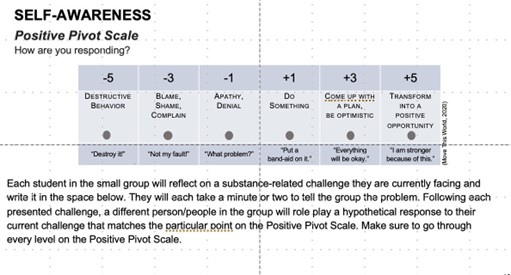
Note to Facilitator(s): Created by Move this World (2020), the Positive Pivot Scale helps students examine their responses to conflicts and challenging situations. The Positive Pivot Scale highlights our choice when it comes to responding to challenges. Practicing the Positive Pivot Scale equips students to be aware of their reactions and responses to challenges, so they discover that they too have a choice in their response.
Practicing the Positive Pivot Scale
Instructions: In a small group setting, instruct students to find a partner (These instructions can be
applied to one-on-one settings too). All students should reflect on a challenge they are currently facing. Partner A will have three minutes to tell Partner B about the challenging situation. After three minutes, you will call out different points on the Positive Pivot Scale, in any order. Partner A will role play a hypothetical response to their current challenge that matches the particular point on the Positive Pivot Scale. Make sure to go through every level on the Scale. Partner B should remain actively listening as Partner A goes through their responses. Do this for five minutes, and then switch partners, and repeat the above steps with Partner B, while Partner A remains actively listening.
Debrief:
Have a discussion with students:
- Did your feelings or perspectives about your challenge shift at all throughout this exercise? Invite pairs to share.
- Which point on the Positive Pivot Scale do you typically display when reacting to your challenges?
- What tangible steps can you take to move higher up on the Positive Pivot Scale?
selmovethisworld.com
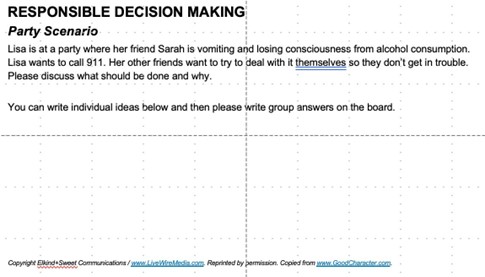
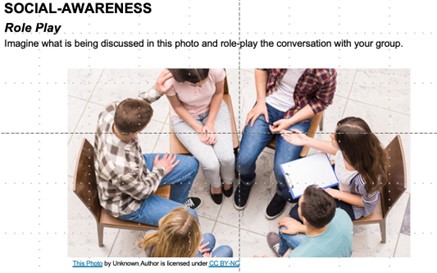
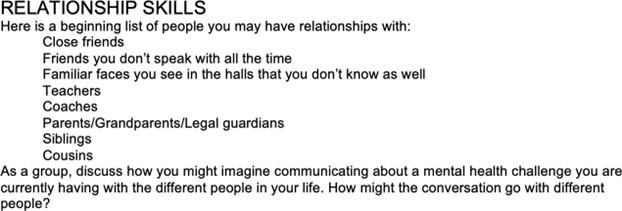
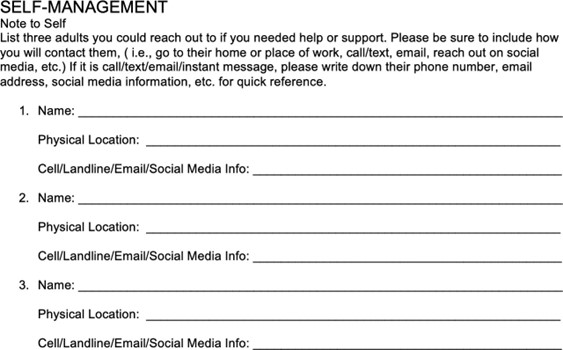
 Thank You!
Thank You!
Open the floor for any closing thoughts/questions from the group.
Thank you for being an amazing facilitator and helping your group to learn critical SEL skills while empowering them to make healthy choices around substance use.
If you have any questions, please do not hesitate to contact our team.
References
Aguilar, C. & Bridges, C. (n.d.). A guide to the core SEL competencies [+ activities and strategies]. Panorama Education. Retrieved April 4, 2023, from https://www.panoramaed.com/blog/guide-to-core-sel- competencies
Collaborative for Academic, Social, and Emotional Learning. (2019, March 12). The case for SEL (Customizable PowerPoint Presentation). Retrieved February 3,
2023, from https://casel.org/fundamentals-of-sel/what-does-the-research-say/
Editorial Team. (2022, July 5). List of team building activities for high school students. Number Dyslexia.
Retrieved May 5, 2023, from https://numberdyslexia.com/list-of-team-building-activities-for-high-school- students/
Frederik, L. (n.d.). Five social emotional learning activities for high school. Panorama Education. Retrieved May 8, 2023, from https://www.panoramaed.com/blog/social-emotional-learning-activities-high-school
Gray, Kevin (2022, November 15). As their focus on gpa fades, employers seek key skills on collage grads’ resumes. National Association of Colleges and Employers. naceweb.org/talent-acquisition/candidate-selection/as-their-focus-on-gpa-fades-employers- seek-key-skills-on-college-grads-resumes/Lewis, R. G., Florio, E., Punzo, D., & Borrelli, E. (2021).
The Brain's Reward System in Health and Disease. Advances in experimental medicine and biology, 1344, 57–69. https://doi.org/10.1007/978-3-030-81147-1_4
Lessons for SEL (2020, June 5). What is social emotional learning (SEL): SEL learning lessons week 12[Video]. YouTube. https://youtu.be/87zTsJ_Fxhc
Macrovector. (n.d.). Brain Infographics [image in infographic]. Freepik.com. https://www.freepik.com/free- vector/brain-inforgaphics-set_1530498.htm
Move This World. (2020, July). Positive Pivot Scale. Retrieved May 9, 2023, from https://sel.movethisworld.com/d2l/lor/viewer/view.d2l?ou=6606&loIdentId=903
Waterford. (2018, December 18). 15 activities for teaching CASEL core competencies. Retrieved May 7, 2023, from https://www.waterford.org/education/15- activities-for-teaching-casel-core-competencies/Pathway 2 Success. (2021, October 18).
10+ self-awareness activities for kids. The Pathway 2 Success. Retrieved May 9, 2023, from thepathway2success.com/10- self-awareness-activities-for-kids/
Romer, D., Reyna, V. F., & Satterthwaite, T. D. (2017). Beyond stereotypes of adolescent risk taking: Placing the adolescent brain in developmental context. Developmental cognitive neuroscience, 27, 19–34. https://doi.org/10.1016/j.dcn.
Stanford Medicine Children’s Health. (n.d.). Understanding the teen brain. Retrieved May 6, 2023, from https://www.stanfordchildrens.org/en/topic/default?id=understanding-the-teen-brain-1-3051
